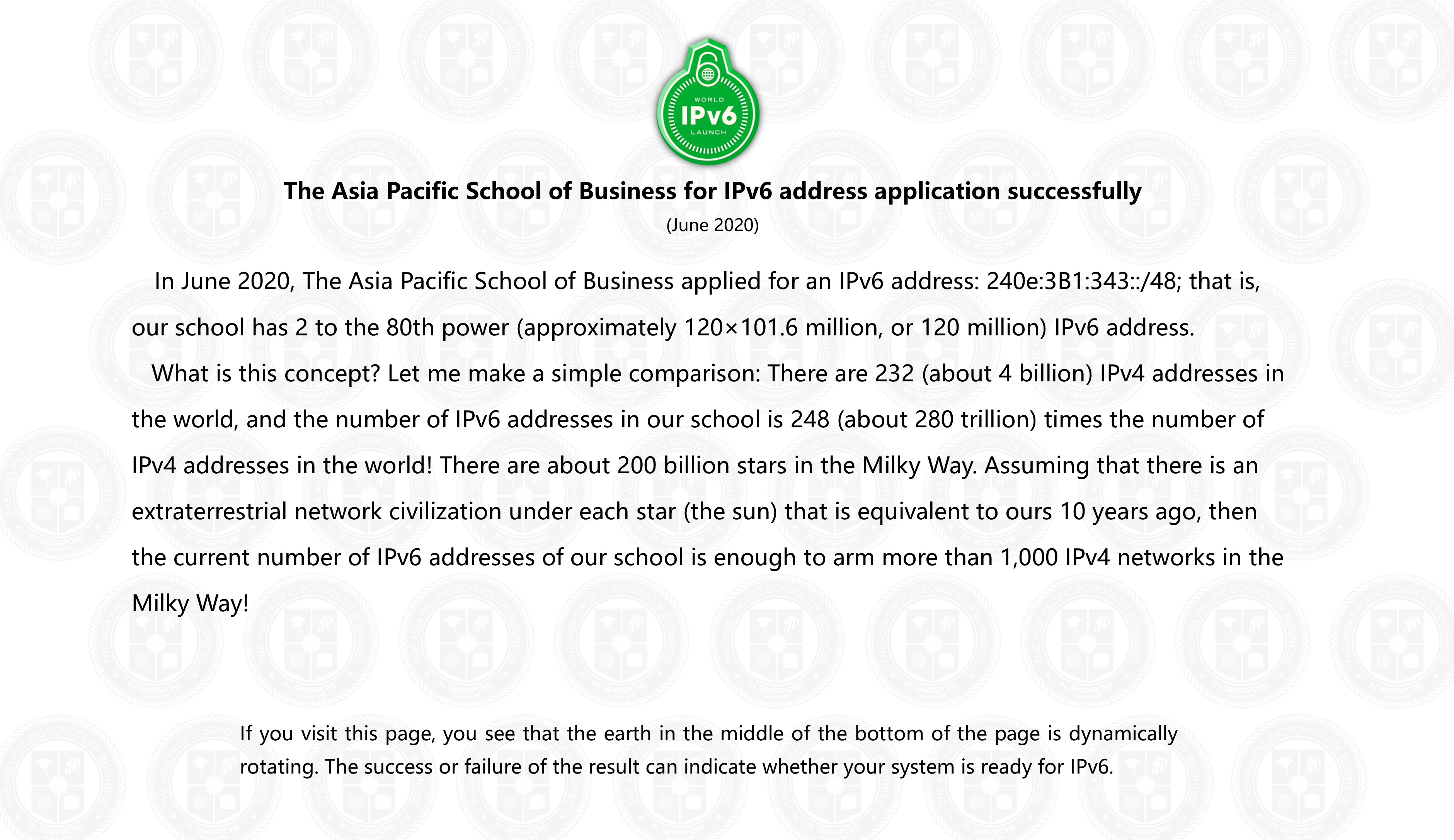Announcement
APSB FOR IPV6 ADDRESS APPLICATION SUCCESSFULLY


IPv4 Address Exhaustion and IPv6
Internet Protocol version 4 (IPv4) was deployed since early 1980's. It uses 32-bit addresses that provides a limited number of Internet addresses (232 or about 4.3 billion). As the Internet grows, IPv4 addresses will be exhausted eventually.
The IP address space is globally managed by Internet Assigned Numbers Authority (IANA). IANA delegates the allocation of IP addresses to five Regional Internet Registries (RIRs), and each RIR is responsible for allocating IP addresses to organisations in their designated areas. The Asia-Pacific Network Information Centre (APNIC) is the RIR for the Asia Pacific region.
IANA allocated the last batch of IPv4 address blocks to the five RIRs (including APNIC) on 3 February 2011. This implies that the global free pool of available IPv4 addresses has been fully depleted.
On 15 April 2011, APNIC announced that its IPv4 address pool had left only 16 million addresses. Since then, each APNIC member organizations can request for at most one block of 1,024 IPv4 addresses. The objective of this arrangement is to reserve IPv4 address space for new users who have no IPv4 addresses and for existing users who need IPv4 addresses for IPv6 transition.
On 14 September 2012, the RIPE Network Co-ordination Centre (i.e. the RIR for Europe, the Middle East and some parts of Central Asia) also announced that only the last block of 16 million IPv4 addresses is available for further allocation. Thereafter, each member organisation can only request RIPE for allocation of at most 1,024 IPv4 addresses.
In June 2014, LACNIC, the Regional Internet Registry for Latin America and the Caribbean, announced that it had reached the last 4 million IPv4 addresses, and LACNIC's pool of IPv4 addresses was considered officially exhausted. LACNIC will assign IPv4 addresses to its members with stricter IPv4 address assignment policies.
In September 2015, ARIN, the Regional Internet Registry for North America, announced that the final IPv4 addresses in its free pool were issued. ARIN's pool of IPv4 addresses was considered officially exhausted.
IPv4 address exhaustion will not have immediate impact to the normal operation of the existing Internet and websites. It only means that there is no more unallocated IPv4 addresses. By the time when the IPv4 addresses space is fully exhausted, the Internet will continue to work and the IPv4 addresses already in use will continue to function. However, it will be difficult and costly to get large blocks of IPv4 addresses as it is only available through the transfer of allocated addresses.
IPv6
IPv4 address exhaustion is one of the driving forces to the advent of IPv6. IPv6 is a network layer protocol similar to IPv4. While IPv4 uses 32-bit addresses, IPv6 uses 128-bit addresses which can provide 2128 (or about 3.4x1038) unique IPv6 addresses.
The major objective of IPv6 is to resolve the address shortage problem of IPv4. However, after considering the lessons learned in deploying and operating IPv4, the designers of IPv6 have built a number of new capabilities into the IPv6 standard, which will bring advantages over IPv4:
- Address availability – provide large number of IP addresses
- Integrated support for Multicast - enhance the support of a network technology for the delivery of information to a group of destinations simultaneously
- Elimination of Network Address Translation (NAT) middle-box - no need to modify network address information in datagram packet headers while in transit across a traffic routing device for the purpose of remapping a given address space into another
- Improved network efficiency - simplify IP header format to achieve higher efficiency in network routing and packet handling
- Auto-configuration – facilitate users to connect host machines to the network with minimal configuration (plug-and-play)
- Quality of Service (QoS) enhancement - improve the support of a traffic prioritization mechanism to guarantee the network performance of certain applications or users.
- Inherent IPSec Security - include end-to-end security features for communications over the network
- Mobility Support - enable mobile devices to move between different networks and maintain the Internet connection
More detail of the basics of IPv6, IPv6 related information portals and websites managed by RIRs and international bodies can be found in the IPv6 Resources section.
Nevertheless, the pace of IPv6 implementation at the commercial or the consumer level is still slow. This can mainly be accounted for by the following issues:
- All IPv4 sites will be operating normally when the IPv4 addresses are exhausted.
- Use of Network Address Translation (NAT), reuse of allocated Internet address may defer the deployment of IPv6.
- IPv6 is not backward compatible with IPv4. Hardware, software and application changes may be required and this leads to cost and resource issues.
- There could be security concerns in implementing IPv6. Currently, the number of security attacks on IPv6 protocol is small. Content providers and Internet service providers may worry about security uncertainties when they start to deliver IPv6 services.
- Lack of "Killer Application" for IPv6 which has the requirement of massive number of IP addresses, i.e. a good business case or strong demand for implementing IPv6 immediately.
IPv4 and IPv6 are expected to coexist in the Internet for some years. At the moment, it is hard to predict whether or when IPv6 will replace IPv4. Nevertheless, the transition of the Internet to Internet Protocol Version 6 is the only available long-term solution to IPv4 address exhaustion.
IPv6 Resources
The following web sites and information portals contain detail information on IPv6 and updates on the IPv6 development in the world.
Regional Internet Registries
A regional Internet registry (RIR) is an organization overseeing the allocation and registration of Internet number resources (e.g. IP address) within a particular region. There are currently five RIRs. Each RIR provides abundant information and guidelines on IPv6.
AfriNIC IPv6 Portal (Africa)
ARIN IPv6 Wiki (North America)
LACNIC portal IPv6 (Latin America)
IPv6 Act Now website by RIPE NCC (Europe, the Middle East and Central Asia)
IPv6 Development in Mainland China
Statistical Reports on the Internet Development in China
Development of internet industry of China
China Education and Research Network (CERNET)
IPv6 implementation in the nationwide education and research computer network in the mainland China (Simplified Chinese)
Other IPv6 information Portals
A web site running a mathematic predictive model to project the exhaustion of IPv4 address.
A worldwide consortium of industries, research and educational networks to advocate IPv6 by improving technology, market and user awareness of IPv6.
A portal to facilitate the deployment of IPv6 technology and applications that operated by IPv6 Forum, European IPv6 Task Force and other IPv6 related parties.
IPv6 Dissemination and Exploitation (6DISS)
6DISS is a two-and-a-half-year European project to provide IPv6 training and knowledge transfer to research networks in developing regions.
IPv6 in Action
The "IPv6 In Action" Project aims to help the general public and Small and Medium Enterprises (SMEs) to better understand the IPv4 address space exhaustion situation and to raise their awareness of IPv6. Sponsored by The Office of the Government Chief Information Officer (OGCIO), the project is organised by the Internet Society Hong Kong and supported by a number of Co-operating Partners and Supporting Organisations. The project was completed and the website was closed on July 2018.
Abundant of information in IPv6 can also be found in the Wikipedia.











